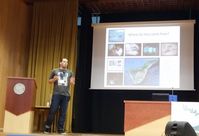 izeThe last 3rd February 2017, Airam Rodríguez presented the oral communication entitled "Is light pollution a barrier in the breeding habitat of seabirds" in the symposium "Current biodiversity conservation challenges" chaired by M.B. García & J. Lahoz‐Monfort within the XIV MEDECOS & XIII AEET meeting. This contribution is co-authorized by A. Rodríguez, B. Rodríguez, and J.J. Negro from Estación Biológica de Doñana (EBD-CSIC) and Grupo de Ornitología e Historia Natural de las Islas Canarias (GOHNIC) and the abstract reads: "Many burrow-nesting seabirds are nocturnal at their breeding colonies, i.e. visit the colonies at night. Petrel and shearwater fledglings are attracted and disorientated by artificial lights at night when they leave the nest and fly for first time towards the sea. If they are ground and not rescued, they have a high probability of perishing. In contrast, adults nesting on inland colonies have to cross over the cities or avoid the lit areas to reach their nests several times during the breeding period. How birds manage that situation may offer useful information to minimise light-induced mortality. Our aim is to study the behaviour of Cory’s shearwaters Calonectris diomedea borelais during the commuting flights (adults) or dispersal (fledglings) to their breeding colonies in relation to spatial distribution of light pollution. We use GPS data-loggers to track birds from several colonies on Tenerife, Canary Islands. Nocturnal satellite imagery is employed to evaluate the spatial distribution of light polluted areas. While fledglings are attracted and grounded in the closest lights to their natal colonies, adults fly over the cities without apparently avoiding artificial lights by using the shortest distance from coastlines to their colonies. Due to high elevation of nesting colonies, return flights were longer than outgoing flights as adults glided from colony to the ocean. Artificial lights do not seem to be a problem for adult shearwaters attending their nesting colonies, but constitute an important barrier for fledglings’ dispersal."
0 Comments
Leave a Reply. |
AuthorIn that section, the most relevant news about the project and other news related to seabird conservation will be highlighted Archives
October 2023
Categories |

 RSS Feed
RSS Feed
